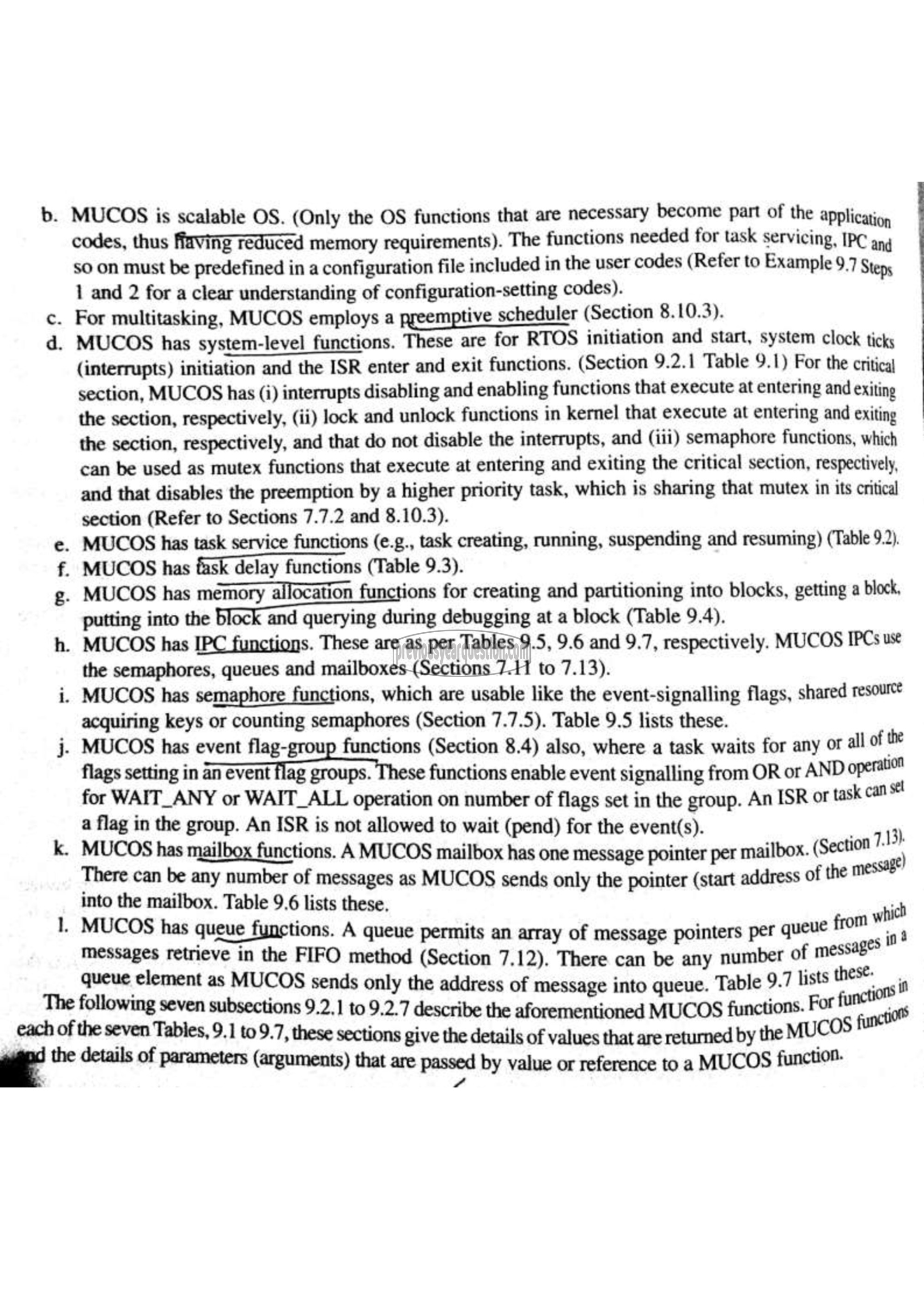APJ ABDUL KALAM TECHNOLOGICAL UNIVERSITY Previous Years Question Paper & Answer
Semester : SEMESTER 6
Subject : Embedded System
Year : 2018
Term : MARCH
Scheme : 2015 Full Time
Course Code : EC 308
Page:66
b. MUCOS is scalable OS. (Only the OS functions that are necessary become part of the Application
codes, thus faving reduced memory requirements). The functions needed for task servicing, IPC ang
50 on must be predefined in a configuration file included in the user codes (Refer to Example 9.7 Steps
1 and 2 for a clear understanding of configuration-setting codes).
c. For multitasking, MUCOS employs a preemptive scheduler (Section 8.10.3).
d. MUCOS has system-level functions. These are for RTOS initiation and start, system clock ticks
(interrupts) initiation and the ISR enter and exit functions. (Section 9.2.1 Table 9.1) For the critical
section, MUCOS has (i) interrupts disabling and enabling functions that execute at entering and exiting
the section, respectively, (ii) lock and unlock functions in kernel that execute at entering and exiting
the section, respectively, and that do not disable the interrupts, and (iii) semaphore functions, which
can be used as mutex functions that execute at entering and exiting the critical section, respectively,
and that disables the preemption by a higher priority task, which is sharing that mutex in its critical
section (Refer to Sections 7.7.2 and 8.10.3).
MUCOS has task service functions (e.g., task creating, running, suspending and resuming) (Table 9.2).
MUCOS has fask delay function delay functions (Table 9.3).
g. MUCOS has ساس سے سے for creating and partitioning into blocks, getting a block,
putting into the block and querying during debugging at a block (Table 9.4).
h. MUCOS has IPC functions. These are as per Tables 9.5, 9.6 and 9.7, respectively. MUCOS IPCs use
the semaphores, queues and mailboxes (Sections 7.11 to 7.13).
. MUCOS has semaphore functions, which are usable like the event-signalling flags, shared resource
acquiring keys or counting semaphores (Section 7.7.5). Table 9.5 lists these.
j. MUCOS has ത്തി (Section 8.4) also, where a task waits for any or all of the
flags setting in an event flag groups. functions enable event signalling from OR or AND operation
for WAIT_ANY or WAIT_ALL operation on number of flags set in the group. An ISR or task can 8!
a flag in the group. An ISR is not allowed to wait (pend) for the event(s). 3
k. MUCOS has mailbox functions. A MUCOS mailbox has one message pointer per mailbox. (Section 1.3.
There can be any number of messages as MUCOS sends only the pointer (start address of 08 0628:
into the mailbox. Table 9.6 lists these. 5
٠ MUCOS has queue functions. A queue permits an array of message pointers per queue 000) ழ்
messages retrieve in the FIFO method (Section 7.12). There can be any number of messages
queue element as MUCOS sends only the address of message into queue. Table 9.7 lists these
യം! ലം سر بعص 9.2.1 9.2.7 describe the aforementioned MUCOS functions. For थ کے
مت “पुल ∙∙ ∙⋯⋯≞⋁∘⊯⋯∘∱⋁⊞∥∞⋯⋯∾∾⊡∞↻∃⊯∥⋃∙∁
ല് details of parameters (arguments) that are passed by value or reference to a MUCOS function.
5 54
mo
